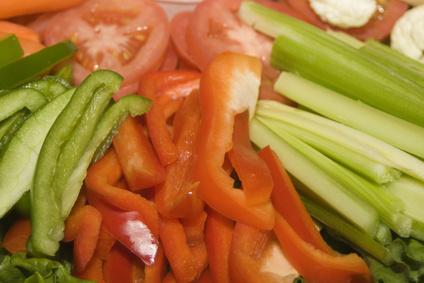When a person is diagnosed with diabetes, it means that their blood cannot process glucose, or sugar, properly, leading to spikes in blood sugar. Type 2 diabetes occurs when a person’s body becomes resistant to insulin, the hormone that normally brings glucose to the body’s cells. During pregnancy, some women develop gestational diabetes, where hormones from the placenta disturb the body’s ability to respond to insulin. Diabetics can attempt to control their disease by making changes to their diet.
Variety
A good diabetic diet thrives on a person eating a wide variety of healthy foods. A diabetic’s diet should not feel limiting to her, as she has a wide range of foods to choose from. The American Diabetes Association recommends that diabetics load up their plates with plenty of colorful fruits and vegetables, including leafy greens, such as spinach and kale. The ADA also recommends that diabetics choose fish at least twice a week and eat beans, such as black beans and pinto beans, regularly. Lean meat and whole grain foods are also good choices for diabetics.
Portions
Even if you eat healthy foods on a diabetic diet, you need to watch your portion size. It is possible to eat too much of a good thing. Talk with a nutritionist or dietitian to determine how many calories you need to eat daily to keep a healthy weight or lose some weight to help control diabetes. The Mayo Clinic recommends that you get 45 to 65 percent of your daily calories from carbohydrates, 15 to 20 percent from protein and 20 to 35 percent from fat.
Benefits
Unlike other special diets, eating a diet to control your diabetes does mean you have to eat unusual foods or a different meal than other members of your family. A diet that is good for diabetics is good for non-diabetics as well, according to WebMD, since it should include lots of vegetables, fruits and whole grains. According to the ADA, foods that you eat to help control diabetes, such as beans, leafy greens and berries, will provide you with other necessary nutrients, such as calcium and potassium.
Monitoring Intake
Diabetics should monitor their intake of carbohydrates, such as starch and sugar, as well as their intake of fats. Diabetics need to keep their fat and cholesterol levels under control since the disease often increases the risk of heart attack or stroke. Some diabetics may need to go on a special TLC diet, or diet to reduce levels of LDL cholesterol, according to WedMD. People on a TLC diet should aim to eat 20 to 30 grams of fiber daily and reduce the amount of saturated fat in their diet to 7 percent or less of their total daily calories.
Misconceptions
Although a person with diabetes needs to monitor how many carbohydrates she consumes each day, it is a myth that she needs to avoid all carbohydrates. While a diabetic will find that she may need to cut back on the amount of desserts she eats, sweets are not verboten on a diabetic diet. Another common misconception is that eating extra protein instead of carbohydrates is beneficial. Eating too much protein can also lead to eating too much fat, as foods with plenty of protein, such as meat, also tend to have plenty of fat.
Photo Credit
- vegetables image by cherie from Fotolia.com





